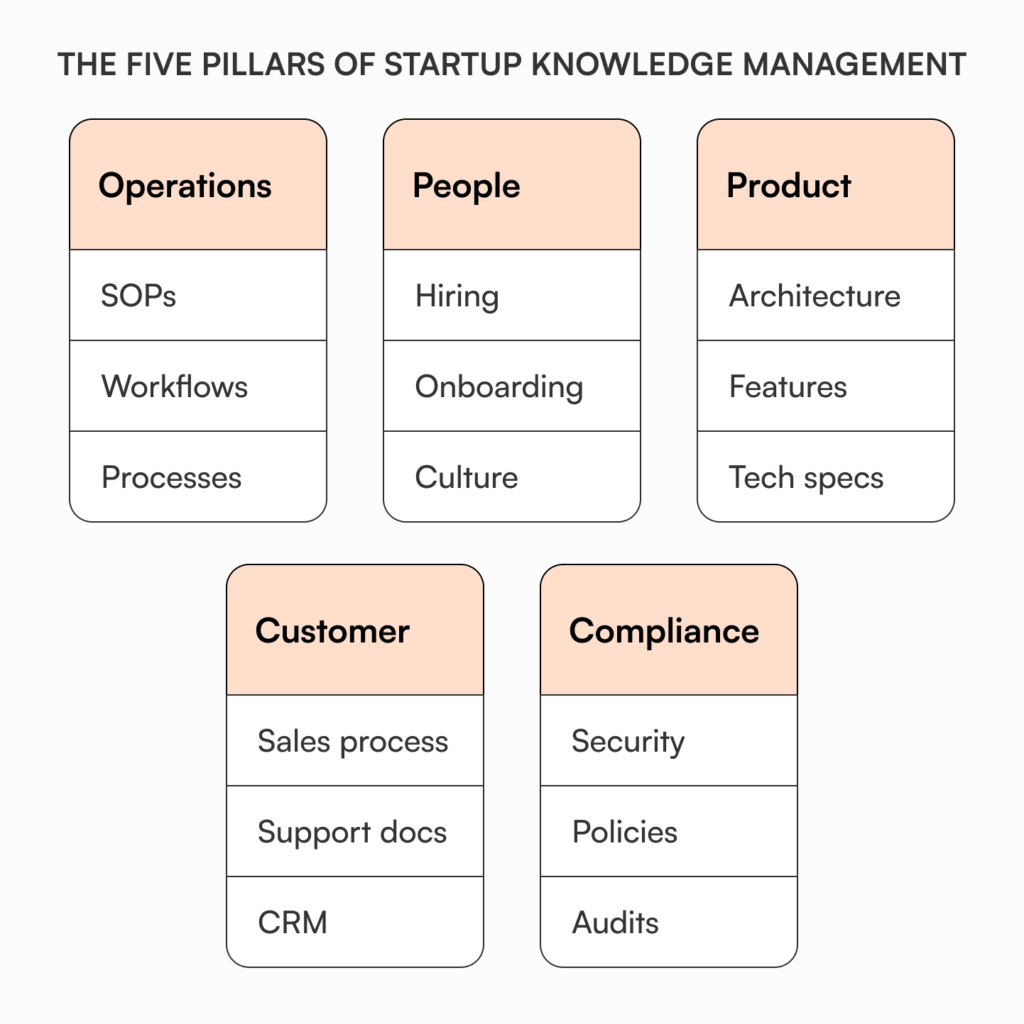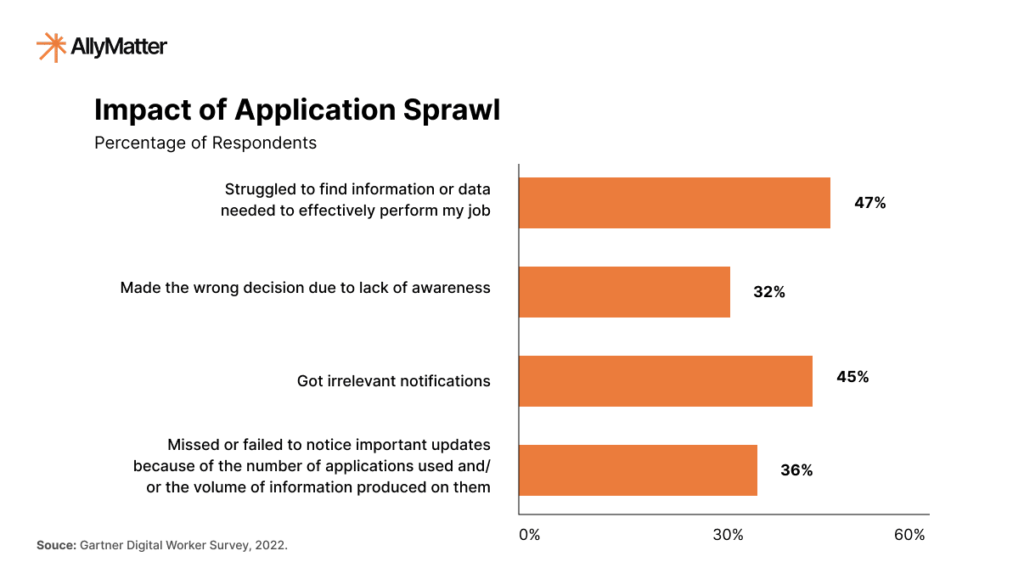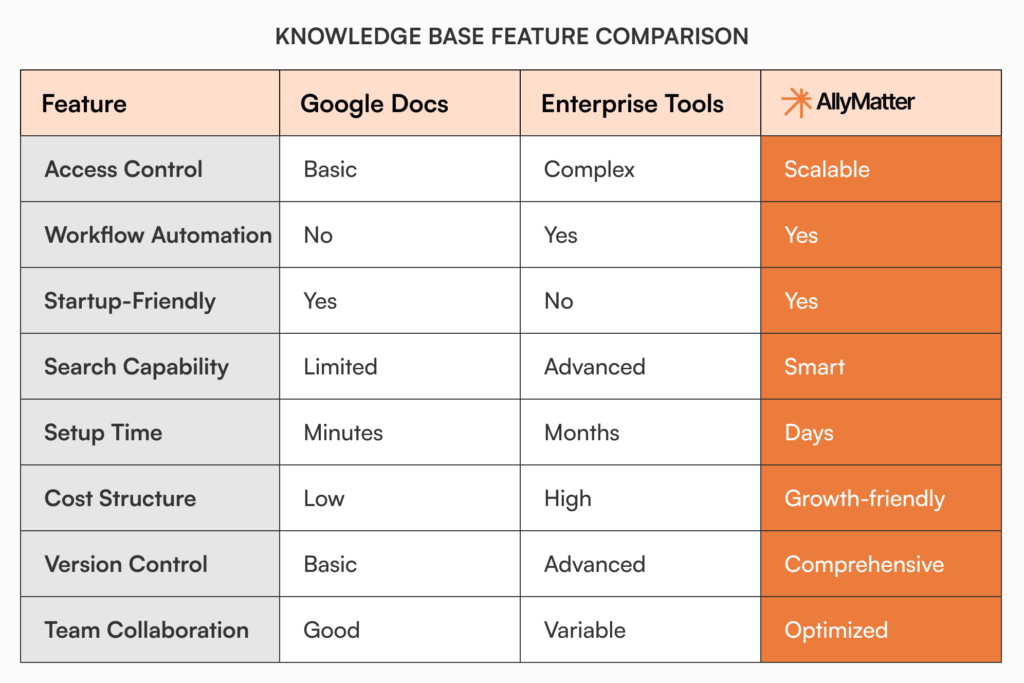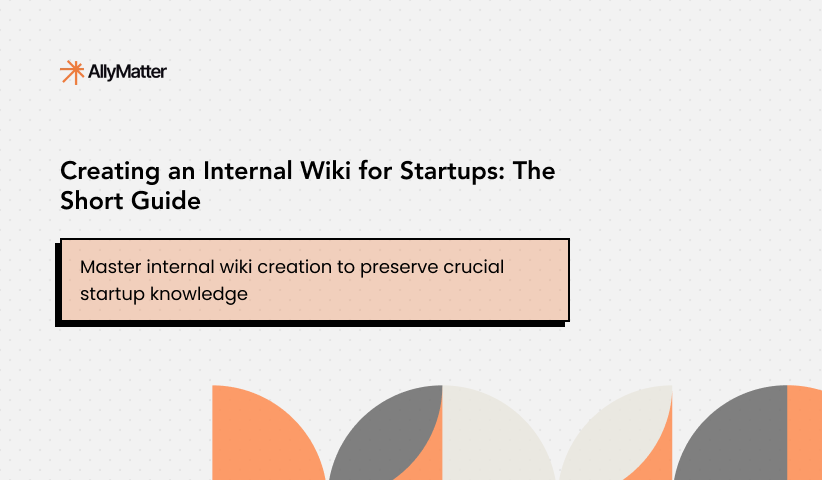The message comes at 11:47 PM on a Sunday: “Hey, quick question – how do we handle refunds again?”
Your heart sinks. Not because it’s a bad question, but because you realize the answer lives entirely in your head, scattered across old Slack threads, and buried in that Google Doc someone created six months ago that no one can find anymore.
Welcome to the startup knowledge crisis. You’re moving fast, breaking things, and building something amazing. But somewhere between your first customer and your tenth employee, critical information starts living in people’s heads instead of accessible systems. Processes become tribal knowledge. Decisions get made in hallway conversations. And suddenly, your biggest competitive advantage, your team’s collective intelligence, becomes your biggest bottleneck.
This isn’t about becoming corporate or bureaucratic. It’s about turning the chaos of startup knowledge into a systematic competitive advantage. Because the companies that figure out knowledge management early don’t just scale faster – they scale smarter.
Why knowledge bases are mission-critical for startup success
The startup scaling inflection points
Something fundamental shifts at key employee thresholds in every startup’s journey. Understanding these inflection points helps explain why knowledge management isn’t optional – it’s existential.
The 2→10 employee shift:
With two people, knowledge sharing happens naturally through proximity and shared context. But as you approach ten employees, communication paths explode from 1 to 45 possible connections. Information begins fragmenting across different minds, time zones, and working styles.
The 10→20 employee crisis
This is where most startups hit their first real knowledge management wall. New hires spend weeks excavating basic processes. The same questions hit Slack daily. Early employees become involuntary help desks instead of focusing on their core work. Without intervention, growth velocity actually decreases despite adding talent.
The 20→50 employee transformation
Companies that successfully navigate this phase have figured out how to distribute knowledge beyond tribal sharing. Those that haven’t often stall here, with founders becoming permanent bottlenecks and new hires struggling to contribute meaningfully.

For a detailed exploration of this critical transition, read our guide From 2 to 20 Employees: The Documentation Pivot Every Startup Misses which provides specific strategies for navigating each inflection point successfully.
The real costs of startup knowledge silos
Poor knowledge management creates cascading problems that compound exponentially:
The founder bottleneck effect
When critical information lives only in founders’ heads, you become the single point of failure for everything from customer questions to technical decisions. Your growth stalls not because you can’t hire good people, but because those people can’t access the knowledge they need to be effective. Every vacation becomes a company crisis, and scaling requires cloning yourself rather than building systems.
The onboarding nightmare
Industry research shows it takes 8-12 months for new hires to reach full productivity in most organizations. For startups burning cash monthly, this timeline is devastating. Every new hire becomes an expensive archaeology project, spending weeks excavating processes and context that should be readily available. Your time-to-productivity stretches from days to months, multiplying your effective hiring costs.
To learn how to dramatically reduce onboarding time and get new hires productive immediately, check out Zero to Onboarded in 3 Days: The Startup’s Guide to Self-Service Employee Onboarding.
The consistency crisis
Without documented processes, every team member invents their own approach. Customers receive wildly different experiences depending on who serves them. Quality becomes unpredictable. Your carefully crafted brand promise dilutes into whatever each person thinks sounds right, destroying the consistency that builds trust and referrals.
The innovation trap
When teams can’t learn from past decisions, both successes and failures, they repeat expensive mistakes. That market expansion you tried last year that didn’t work? New hires will propose it again, and you’ll waste cycles learning the same lessons multiple times. Failed experiments become perpetual recurring costs rather than accumulated wisdom.
When evaluating documentation priorities, ask:
- Does this decision affect multiple departments? → Document immediately
- Will new hires need this context? → Include in onboarding materials
- Has this question been asked more than twice? → Create searchable answer
The competitive advantages of strategic documentation
Startups that implement knowledge management early unlock unfair advantages that compound over time:
Execution velocity
When information is accessible and processes are clear, teams move significantly faster. Decisions happen without endless context-gathering meetings. New features ship without requiring founders to explain strategic reasoning to every team member. Velocity increases with team size rather than decreasing.
Culture that scales
Your values and approaches aren’t trapped in the minds of early employees – they’re documented, shareable, and reinforceable. New hires absorb your culture through clear examples and explicit frameworks rather than osmosis and guesswork. Cultural consistency becomes a sustainable competitive advantage rather than a scaling liability.
Learning that compounds
Each success and failure becomes institutional knowledge rather than individual experience. Teams build on accumulated wisdom instead of starting from scratch. Your collective intelligence grows with your headcount rather than diluting across more minds.
Operational resilience
Key person risk decreases dramatically when knowledge is systematically captured. Departures don’t create knowledge voids. Sick days don’t cause workflow breakdowns. Your operations become antifragile rather than dependent on specific individuals.
The five pillars of startup knowledge management
Effective startup knowledge bases organize around five critical pillars that support different aspects of business operations.

Pillar 1: Operations & processes (the startup machine)
This pillar captures how work actually gets done in your startup. It includes standard operating procedures, workflow documentation, tool usage guidelines, and process optimization insights. Unlike corporate process documentation, startup operational knowledge must be lightweight, actionable, and adaptable to rapid change.
Pillar 2: People & culture (the startup DNA)
Cultural knowledge is often the most valuable and most fragile aspect of startup intellectual property. This pillar preserves hiring practices, onboarding frameworks, performance management approaches, and the behavioral norms that create your unique work environment. As you scale, documented culture becomes the immune system that maintains your identity.
For a deep dive into why HR documentation is critical for startup success and how to implement it effectively, read our detailed guide If It’s Not Documented, It Doesn’t Exist: Why Your Startup Needs a Living HR Handbook.
Pillar 3: Product & engineering (the startup core)
Technical knowledge includes architectural decisions, feature development rationale, customer feedback integration, and engineering best practices. For startups, this knowledge is particularly critical because early technical decisions create compound effects that influence every future development choice.
When it comes to product documentation specifically, most founders struggle with balancing comprehensiveness with time constraints. Our practical guide, Product Documentation for the Solo Founder & Startups, shows how to create effective product documentation without the overwhelming time investment.
Pillar 4: Customer & sales (the startup engine)
Customer-facing knowledge encompasses ideal customer profiles, sales methodologies, support procedures, and relationship management practices. This pillar transforms founder-dependent sales and support into scalable, repeatable systems that maintain quality while increasing volume.
Founder-led sales often feels impossible to systematize, but it’s essential for scaling beyond personal capacity. Learn how to capture and scale your sales knowledge with Build a Founder Sales Playbook That Scales from First to 50th Customer.
Pillar 5: Compliance & security (the startup foundation)
Regulatory and security knowledge becomes increasingly important as startups mature. This pillar includes access management, data protection procedures, audit preparation materials, and risk management frameworks. Early documentation in this area prevents expensive compliance scrambles during funding rounds or enterprise sales cycles.
Building your startup knowledge base: Practical framework
Starting simple vs. over-engineering
The most common startup knowledge management mistake is over-engineering the initial system. Founders often delay documentation because they envision complex, perfect knowledge bases that require significant upfront investment. This perfectionism paralysis results in zero documentation rather than imperfect but useful documentation.
Start with the simplest possible system that captures essential knowledge. The key is establishing the habit of documentation and the culture of knowledge sharing. Platform sophistication can evolve as needs become more complex.
For actionable guidance on starting your documentation practice immediately, even during the most chaotic early days, check out Your First 48 Hours of Startup Documentation: What to Write When Everything’s on Fire.
Making it “living” documentation
Static documentation dies quickly in startup environments. Living documentation evolves continuously with business changes. This requires:
Embedded workflows
Documentation updates become part of existing processes rather than separate activities. When policies change, documentation updates automatically. When new procedures are established, they’re immediately captured.
Ownership models
Clear responsibility for maintaining different knowledge areas prevents documentation drift. Owners regularly review and update their sections based on operational changes.
Feedback mechanisms
Users can easily report outdated information, suggest improvements, and contribute updates. The knowledge base becomes a collaborative asset rather than a top-down mandate.
Usage analytics
Understanding which documentation gets used and which gets ignored helps prioritize maintenance efforts and identify gaps in coverage.
The startup documentation journey: Stage-by-stage implementation
Pre-revenue/MVP stage (0-5 employees): Survival documentation
At this stage, documentation feels like procrastination when you’re fighting for product-market fit. However, capturing key decisions and learnings during this chaotic period provides essential context for future scaling. Focus on:
- Customer discovery insights and pivot rationale
- Core product decisions and technical architecture choices
- Early process experiments and their outcomes
- Founding team responsibilities and decision-making frameworks
The goal isn’t comprehensive documentation but rather preserving critical context that would otherwise be lost in the intensity of early-stage execution.
Early traction (5-20 employees): Process documentation
As you prove initial product-market fit and begin scaling the team, process documentation becomes essential for maintaining quality and velocity. This stage requires:
- Standardized operational procedures for core functions
- Customer onboarding and support frameworks
- Engineering practices and quality standards
- Sales methodologies and customer relationship management
Documentation shifts from capturing decisions to enabling execution. The focus moves from historical context to actionable guidance that helps new team members contribute immediately.
Scaling growth (20-50 employees): System documentation
Rapid growth at this stage creates complexity that requires systematic knowledge management. Beyond individual processes, you need integrated systems that support cross-functional collaboration:
- Department-specific knowledge bases with clear interconnections
- Role-based access controls for sensitive information
- Automated workflow management for document approvals and updates
- Comprehensive onboarding systems that work without founder involvement
Series A and beyond (50+ employees): Strategic documentation
At this scale, knowledge management becomes a strategic capability that enables sustained growth. As you approach major funding milestones, the accumulated knowledge of your early team becomes incredibly valuable – and incredibly vulnerable.

For guidance on preserving institutional knowledge before it walks out the door with departing employees, read Pre-Revenue to Series A: Capture Your Startup’s Tribal Knowledge Before It Walks Out the Door.
Special considerations for remote-first startups
The rise of distributed teams has fundamentally changed how startups manage knowledge. In remote-first organizations, documentation isn’t just helpful – it becomes the central nervous system that enables effective collaboration across time zones and locations.
Remote teams face unique challenges: no hallway conversations for quick context sharing, no whiteboard sessions for collaborative problem-solving, and no casual knowledge transfer through physical proximity. These limitations make systematic knowledge management absolutely essential rather than merely beneficial.
For comprehensive strategies on building documentation systems that replace the informal knowledge sharing of co-located teams, explore Effective Knowledge Sharing for Remote & Asynchronous Teams.
The AI-optimized knowledge base
As artificial intelligence becomes integrated into business workflows, forward-thinking startups are structuring their knowledge bases to work effectively with AI systems. This isn’t just about future-proofing – it’s about creating documentation that can power custom AI assistants and automated support systems.
Properly formatted knowledge bases become training data for large language models, enabling startups to create AI-powered customer support, internal Q&A systems, and automated documentation generation. The structure and formatting choices you make today determine how effectively AI can leverage your knowledge base tomorrow.
To understand how to structure your documentation for the AI-driven future, read our forward-looking guide, Make Your Knowledge Base Ready for LLMs & AI.
Building documentation culture and business case
One of the biggest challenges in implementing knowledge management isn’t technical – it’s cultural. Getting busy startup teams to prioritize documentation requires demonstrating clear business value and making the process as frictionless as possible. According to Gartner survey findings, 47% of digital workers struggle to find the information needed to effectively perform their jobs – a challenge that becomes critical as startups scale.

Source: 2022 Gartner Digital Worker Survey
Documentation culture starts with leadership commitment and clear examples of how good documentation creates competitive advantages. When team members see documentation directly contributing to faster onboarding, better customer support, and more efficient operations, adoption becomes natural rather than forced.
For a comprehensive exploration of why documentation investment delivers measurable ROI and how to build sustainable documentation practices, read our foundational article, The Power of Excellent Internal Documentation.
Advanced knowledge base features
As your startup grows and your knowledge base becomes more sophisticated, you’ll need advanced features that go beyond simple document storage. These include:
Access control and security
Different information requires different levels of access. Sensitive HR information, technical architecture details, and strategic plans need granular permission systems that protect confidential information while maintaining accessibility for authorized users.
To understand how to implement sophisticated access controls that scale with your team, explore our detailed guide, Keep Your Docs Safe But Accessible, which covers AllyMatter’s permission and visibility systems.
Version control and audit trails
In fast-moving startups, understanding what changed, when, and why becomes critical for compliance, debugging, and learning. Comprehensive audit trails help teams understand the evolution of decisions and maintain accountability.
For insights into maintaining complete documentation accountability, read How AllyMatter’s Document Audit & History Feature Ensures Accountability.
Workflow automation
As documentation processes become more complex, manual approval workflows become bottlenecks. Automated systems can route documents through appropriate review processes, notify stakeholders of changes, and ensure nothing falls through the cracks.
To understand how workflow automation can transform chaotic approval processes into smooth operations, check out Understanding Document Workflows in AllyMatter: A Comprehensive Guide.
Advanced organization systems
Simple folder structures break down as knowledge bases grow. Sophisticated tagging systems, cross-referencing capabilities, and intelligent search become essential for maintaining usability at scale.
For detailed strategies on organizing complex knowledge bases effectively, explore Tags: The Secret Sauce Behind AllyMatter’s Access Control.
Implementation roadmap: Your next steps
Building an effective knowledge base doesn’t happen overnight, but it doesn’t require massive upfront investment either. Here’s a practical roadmap for getting started:
Week 1: Emergency documentation triage
- Identify the top five questions your team asks repeatedly
- Document quick answers to these questions in a shared location
- Establish one central place where everyone knows to look first
Month 1: Core process documentation
- Document your three most critical business processes
- Create basic onboarding materials for new hires
- Establish ownership for maintaining different knowledge areas
Quarter 1: Systematic knowledge capture
- Implement regular documentation reviews and updates
- Build documentation activities into existing workflows
- Establish metrics for measuring documentation effectiveness
Ongoing: Building documentation culture
- Celebrate and recognize good documentation practices
- Make documentation part of performance reviews
- Continuously refine processes based on usage and feedback
Choosing the right knowledge base platform
While you can start with simple shared documents, growing startups eventually need purpose-built knowledge management platforms. The key is choosing a solution that scales with your needs without over-engineering your initial requirements.
AllyMatter was specifically designed for growing startups that need sophisticated knowledge management without enterprise complexity. The platform provides advanced features like workflow automation, granular access controls, and comprehensive audit trails while maintaining the simplicity and speed that startups require.
Measuring success: Knowledge base KPIs
Effective knowledge management requires measurement to ensure your investment delivers results. Key metrics include:
Time to productivity
How quickly new hires become effective contributors after joining your team. Good documentation should steadily reduce this metric.
Question repetition
The frequency of repeated questions in support channels. Effective knowledge bases dramatically reduce redundant inquiries.
Process consistency
The degree to which different team members follow standardized procedures. Documentation should increase consistency without stifling innovation.
Knowledge retention
How much institutional knowledge remains accessible when team members leave. Strong knowledge management systems prevent expertise from walking out the door.
From startup chaos to systematic competitive advantage
Knowledge management isn’t about becoming corporate or bureaucratic. It’s about building systematic competitive advantages that compound as your startup grows. The companies that figure out knowledge management early don’t just scale faster – they scale more intelligently, preserving the insights and innovations that drove their initial success.
Every day you wait to implement systematic knowledge management, more tribal knowledge walks out the door, more new hires struggle unnecessarily, and more competitive advantages slip away. The best time to start was six months ago. The second-best time is today.
Your startup’s collective intelligence is its most valuable asset. Make sure it’s preserved, accessible, and growing with your team. The documentation habits you build today will determine whether your knowledge becomes a scaling superpower or a growing liability.
Start simple, start today, and start building the knowledge foundation that will carry your startup from survival to success.
AllyMatter: Knowledge management built for startup velocity
Growing companies need knowledge management that moves as fast as they do. While enterprise solutions over-engineer simple problems and basic tools under-serve complex needs, AllyMatter bridges this gap with purpose-built functionality for scaling startups.

Centralized knowledge without the complexity: Stop losing critical information across scattered Google Docs, Slack threads, and email chains. AllyMatter’s intelligent organization system uses smart tags, custom categories, and powerful metadata search to make any document findable in seconds. Your team’s collective knowledge becomes a searchable, accessible asset rather than a frustrating treasure hunt.
Approval workflows that actually work: Manual document approvals create bottlenecks that slow growth. AllyMatter’s automated workflow system routes documents through appropriate review processes, tracks approval status, and notifies stakeholders automatically. Critical policies get updated without chasing down approvers or wondering about status.
Access control that scales with your team: As you grow from 5 to 50 employees, information sensitivity becomes complex. AllyMatter’s granular access control lets you customize permissions by roles, departments, or specific documents. Sensitive HR policies stay protected while operational procedures remain accessible to everyone who needs them.
Documentation that people actually use: The best knowledge base is worthless if your team ignores it. AllyMatter’s clean interface, responsive design, and intuitive search ensure your documentation becomes the first place people look for answers, not the last resort after asking colleagues.
Built-in compliance and audit trails: Every change gets tracked automatically with comprehensive audit logs. See who modified what, when changes occurred, and maintain complete accountability. Whether preparing for funding rounds or enterprise sales, your documentation history demonstrates operational maturity.
Transform scattered startup information into systematic competitive advantage. Get early access to AllyMatter and join growing companies building smarter knowledge systems.
Frequently asked questions
What’s the difference between a knowledge base and internal documentation?
Internal documentation typically refers to individual documents or files that capture specific processes or information. A knowledge base is a systematic approach to organizing, connecting, and making all internal documentation searchable and accessible. Think of documentation as individual puzzle pieces, while a knowledge base is the complete picture that shows how all pieces fit together. For growing startups, scattered documentation becomes unmanageable quickly, making a centralized knowledge base essential for maintaining operational efficiency.
How much time should startups spend on documentation in early stages?
The key is building documentation habits rather than massive upfront time investment. Start with 30 minutes weekly per team member capturing decisions, processes, and learnings as they happen. This prevents the overwhelming catch-up documentation projects that many startups face later. Early-stage documentation should focus on preserving context and decisions rather than creating comprehensive manuals. As you scale, this foundation makes systematic knowledge management much easier to implement.
When should we move from Google Docs to a dedicated knowledge management platform?
Most startups hit the Google Docs wall between 10-20 employees when information becomes difficult to find and maintain. Clear signals include team members asking the same questions repeatedly, new hires spending days hunting for basic information, and important documents getting lost in folder hierarchies. If you’re spending more time searching for information than using it, or if document version control becomes problematic, it’s time for a purpose-built solution.
How do we get our team to actually use and maintain documentation?
Documentation adoption requires demonstrating clear value and removing friction. Start by documenting answers to the most frequently asked questions your team faces. When people see documentation solving real problems immediately, adoption follows naturally. Make updating documentation part of existing workflows rather than separate tasks. Most importantly, leadership must model good documentation behavior consistently.
What happens to our knowledge base if key employees leave?
This is exactly why systematic knowledge management is critical for startups. Without documented processes and captured knowledge, departing employees take irreplaceable institutional knowledge with them. A well-maintained knowledge base ensures that critical information, decision context, and operational procedures survive personnel changes. The goal is making your startup’s intelligence institutional rather than individual, protecting your competitive advantages regardless of team turnover.


